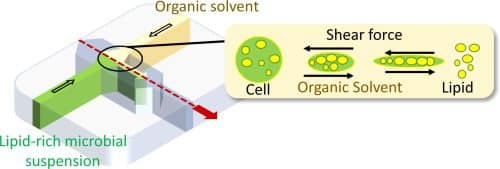A team of chemical engineers succeeded in developing a modern jet mixer for producing biomass from algae by extracting the fats from the water-filled plants, while using less energy compared to existing extraction methods

[Translation by Dr. Nachmani Moshe]
Experts in the field of bio-fuel have been looking for a long time for a more economical method of converting algae into bio-oil, with the aim of powering cars, ships and even jet planes. Researchers from the University of Utah believe they have found a solution. They succeeded in developing an extremely fast and cost-effective method for converting algae to biofuel in large quantities using a dedicated jet mixer.
Within the microorganisms living in the ponds, lakes and streams are stored lipids (fats), which are molecules of fatty acids that form oil that can be extracted and used to drive gasoline engines. When these lipids undergo extraction, the resulting product is called crude bio-oil. This method turns organisms, for example, microalgae, into an important form of biomass, organic matter that can be used as a sustainable fuel source.
These fats are also found in many other single-celled organisms such as yeast used in making cheese. However, the problem associated with using algae to produce biomass has always been the amount of energy needed to extract the fats from the plants, which are full of water-soluble substances. In some methods, more energy is consumed in converting algae to bio-oil than the amount of energy emitted from the process. Researchers from the University of Utah succeeded in developing a new and cost-effective method that allows rapid extraction of the fats using a dedicated jet mixer, a method that consumes much less energy compared to existing extraction methods, a key discovery that promotes the transformation of this form of energy into a sustainable and economical alternative to fuel. The innovative mixer is able to exhaust the fats in seconds. The research findings have long been published in the scientific journal Chemical Engineering Science. "The most important factor in this field is to reduce the amount of energy consumed during the extraction process," says the lead researcher. "We managed to remove a significant development barrier to the production of biofuel from algae in a more efficient and sophisticated manner."


Today, in order to exhaust the high-oil lipids inside the algae, scientists have to remove the water from the algae, in the first step, while obtaining a mixture or dried powder of biomass. This is the stage that needs the greatest amount of energy in the process. In the next step, this product is dissolved in a solvent capable of separating the fats from the biomass. What remains at this stage is a starting material, the crude bio-oil, which is then used to produce algae-based biofuel. In the next step this oil is mixed with diesel to propel trucks, tractors and other large mechanical equipment fueled by diesel. However, in light of the fact that this process consumes a lot of energy to remove the water from the plants in the initial stage of the process, converting algae to biofuel, until today, was not really a practical, efficient or economical method. "Extensive research efforts have been conducted in order to advance the field of biofuel production from algae, but to date an economic balance point has not been reached between the cost and benefit of such an extraction method, so that it would also be commercially practical. Our research may change the equation and bring the field of biofuel production from algae back into the economic game," says one of the researchers from the University of Utah.
The research team developed an innovative extraction-stirring device during which Magov emits jets of the solvent towards jets of the algae, while creating local eddies in which the lipids "skip" a short distance from the algae to the solvent stream. In the next step, the solvent is removed and recycled for reuse in the same process. "Our system makes sure that you don't have to waste a large amount of energy on drying the algae, and our technology is much faster than existing technologies," notes the lead researcher. This technology could be applied far beyond algae, including within a variety of microorganisms such as bacteria, fungi or any other animal/plant source containing fats.
In 2017, about five percent of all energy consumption in the US came from biomass, according to the US Department of Energy. Other forms of biomass include burning wood to produce electricity, ethanol obtained from corn and sugar cane crops, as well as food and garden scraps that end up in the garbage and are then converted into biogas. The benefit of using algae is that they can be grown in ponds, water channels or in dedicated bio-backs, and in the next step use them to produce fuel. The growth of algae in large quantities could also have a positive effect on our environment by reducing the amount of carbon dioxide emitted into the air around us. "The groundbreaking technologies we are developing could lead to a revolution in the development of biofuels based on algae and other single-celled organisms," says the lead researcher.

3 תגובות
It's fast and good
Not renewable energy
Nothing will help, no matter what they invent, until they squeeze the last drop of oil out of the ground - all the inventions and alternative technologies will not raise their heads.